The Apostle Paul visited Corinth in the middle of the first century AD. According to scholars, the Apostle Paul came back to Corinth at least three times. After his first visit he stayed in Corinth one year and a half. (At Ephesus he stayed three entire years.)
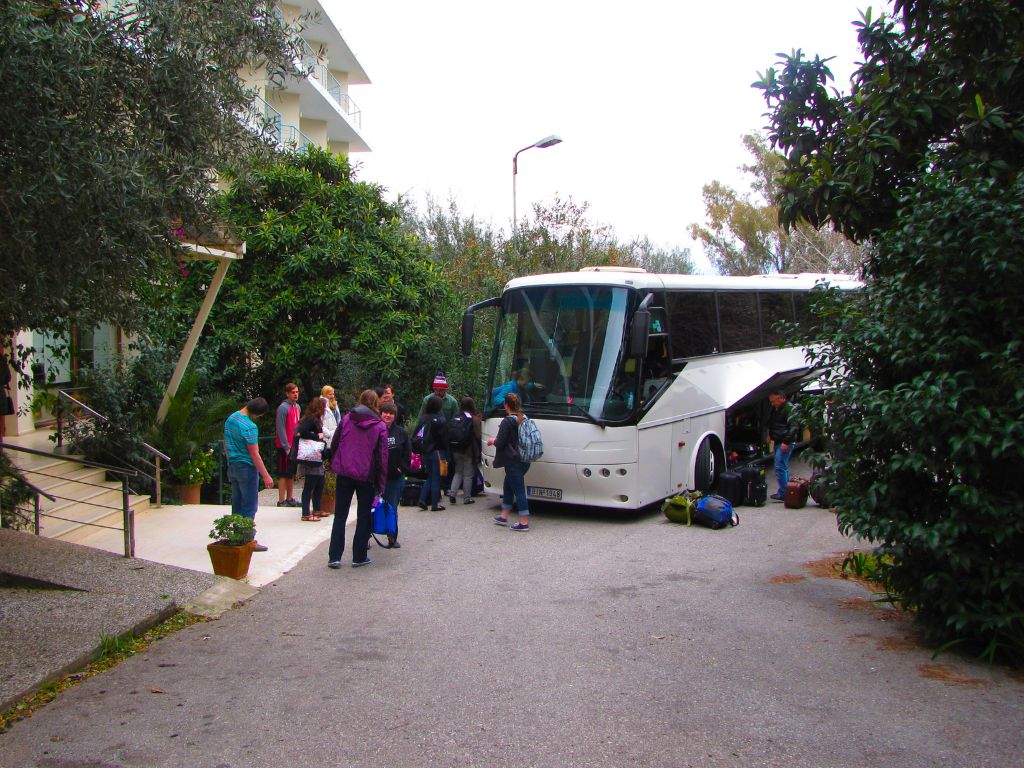
From Corinth, Paul authored First and Second Thessalonians (considered to be the first books of the New Testament.) He also wrote the New Testament book of Romans from Corinth, and for some scholars even the letter to Galatians. The Apostle Paul developed correspondence with the Church of Corinth, from which we have two letters, First and Second Corinthians. The Church of Corinth had as a member of the church one of the richest people of the Mediterranean world, the treasurer Erastus. And here we have God’s humor, perhaps it was Erastus, the sexy one, who delivered the sex slaves of the temple from sex slavery.
Corinth, one of the oldest cities of the Mediterranean world, became especially important after Alexander the Great, due to transport and commercial activity between the east and west. Corinth became a crossroad where three major ancient commercial arteries met on the way to Rome:
- The Spices Avenue went through Antioch of Syria on the way to Rome which also had to go through Corinth.
- The Silk Avenue from China went through Ephesus on the way to Rome and also went through Corinth.
- The Ivory Avenue went from Central Africa through Alexandria of Egypt to Rome which made it necessary to pass through Corinth.
In times past the ships were portaged over a paved pathway. In the Diolkos of today a significant, but narrow canal has been dug out.
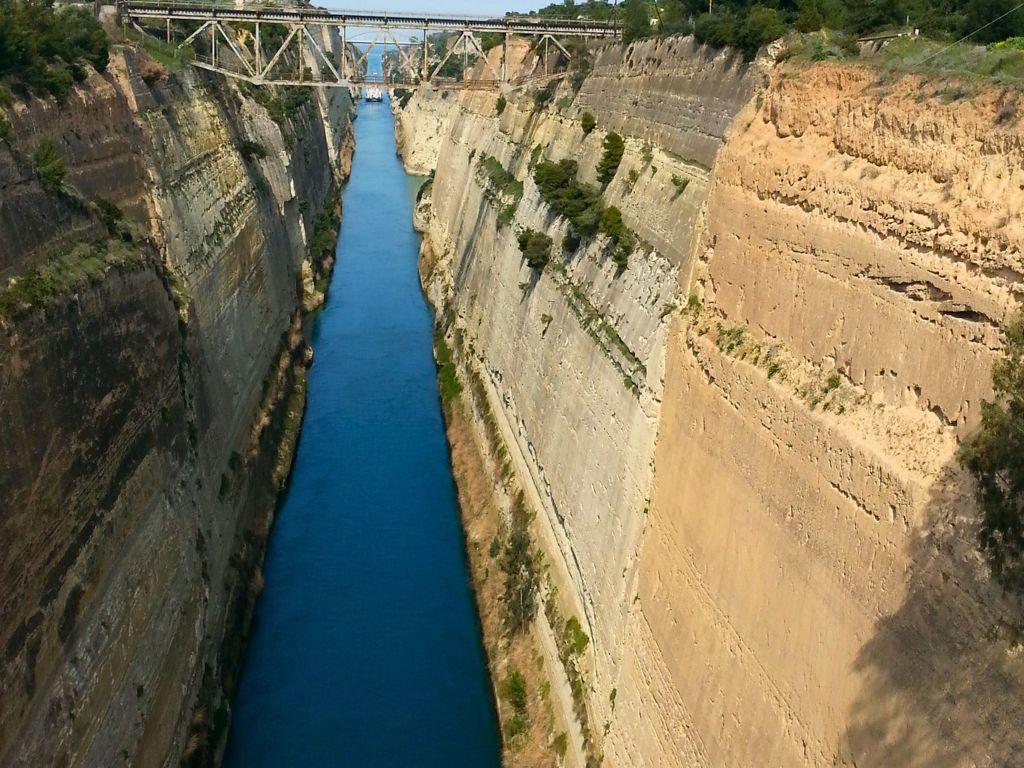
A tugboat and small ship approach the canal, then the canal lowers, and finally, the tugboat and small ship pass through the Diolkos.











There was a proverb which said that not everybody can sail to Corinth because you needed to be extraordinarily rich, a commercial person, a ship owner, able to face spending time and money. This ancient proverb highlighted the expense of coming through Corinth. To go around and make the rounder of Peloponnese was risky due to rough seas caused by the northern winds pushing to northern Africa. The Diolkos was an impressive and expensive service for ships.
At the end of the Diolkos, in the middle of the plain, is the Acropolis of Corinth. Notice the top of the summit.
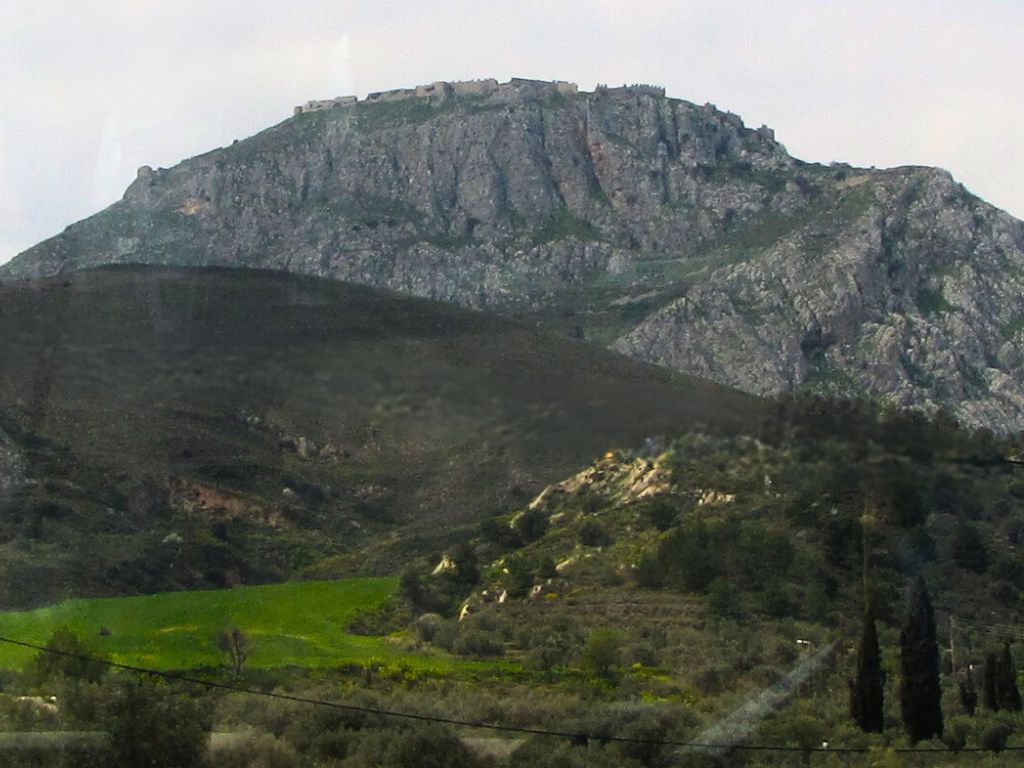
The summit of the Acropolis had enough space (according to the archaeologists) for more than 5000 people to dwell permanently. It was one of the biggest Acropolis in all the ancient world. In the second century before Christ after the subsection of Macedonia, Corinth became the main stronghold of resistance against the Romans. But the Roman Senate gave an order to General Mummius to destroy Corinth in 146 BC. The Roman army entered and leveled the city, totally destroying it. Then for 100 years there was a prohibition against reinhabitation in Corinth. But then commercial transport dysfunctions directly affected the economy of Rome and poor organization of the Isthmian Games caused complaints from Greeks in all of the Mediterranean world. For more than 1000 years the Isthmian games had been organized in Corinth every two years (the second most important games after the Olympic Games.)
So, Julius Caesar, shortly before his assassination in the year 44, decided that Corinth had to be rebuilt. But, after the assassination of Julius Caesar, his successor Octavian Augustus rebuilt the city. Octavian Augustus is considered to be the founder of Corinth – he gave the order to rebuild. The city walls were repaired in the public section while the classical city, the residential area, was buried. New inhabitants were invited to dwell on the new terrain/surface built on top of the classical city. After Corinth was rebuilt, the new city became the capital of the Province of Achaia. The Province of Achaia expanded north up to the edges of the Thessalian Plain including the Rocks of Meteora, and all the way south including all of Peloponnese.
Corinth was one of the most important cities of the empire, and the richest city, at least during the Roman Imperial period. Very special and important cities of antiquity were included in that province including Athens, Thebes, Sparta, sanctuaries of inter-Greek and international significance, and the sanctuary of Olympia where the Olympic Games were held every four years, the sanctuary of Isthmus of the Isthmian Games, the Oracle of Delphi, and the Temple of Demeter in Eleusis where the Eleusinian mysteries were held every year. But Corinth came into a deep decline in 410 AD – from which it never recovered. This sudden decline was due to the collapse of the Western Roman Empire and the conquest of Rome by the Gauls. Up to that time, Corinth was in the middle of the empire. Suddenly Corinth found itself to be a bordering city of the Eastern Roman Empire.
In 1858 an earthquake leveled the city once more. So, the Greek state moved the city to the sea front, eight kilometers northeast, where it is today – leaving the terrain of the ancient city to the archaeologists. The American Archaeological School and the Greek Archaeological Service were eager to discover the classical City of Corinth. They came and started their research. Visitors and archeology schools come to Greece for something that they cannot find in other places.
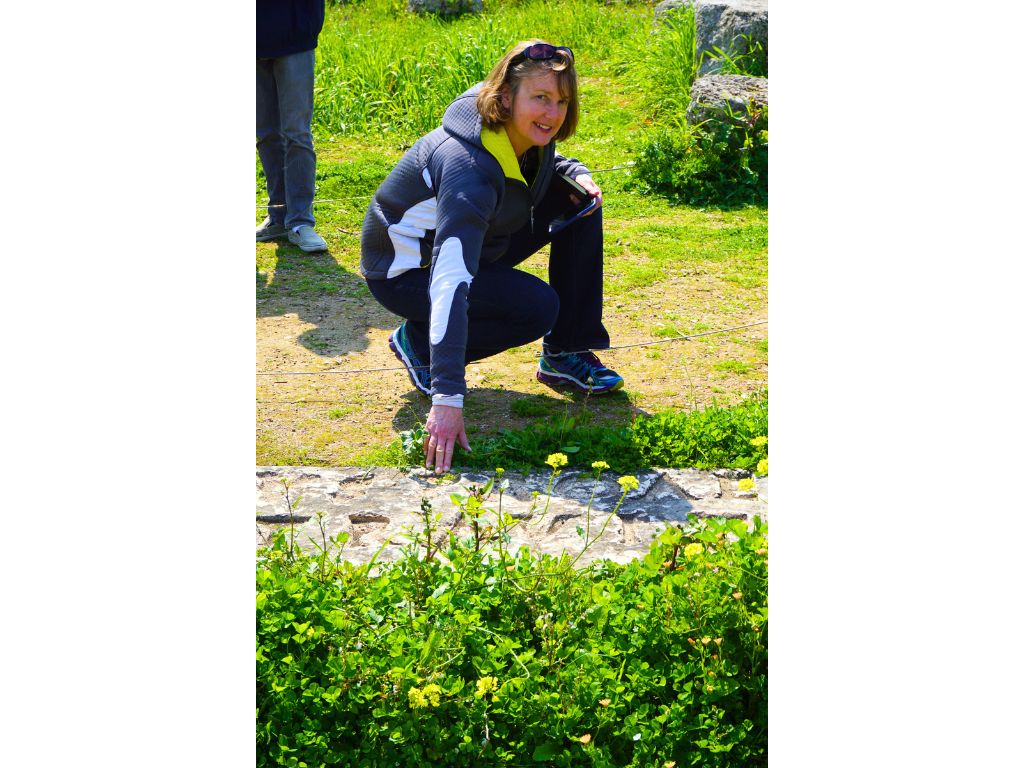
They do not come to Greece for Roman ruins because these can be found in other places of the Mediterranean world. Archeological schools come to Greece to find classical ruins. But because of the well-preserved Roman period layer of the ancient city the archeologists in search of classical ruins were not allowed to remove the Roman ruins. It was thought they would be trying to find something that possibly was not underneath the Roman ruins anymore – because in many cases the Romans recycled prior building material. So gradually, the archaeologists lost their interest in digging for classical ruins in Corinth. The Roman layer, dating back to the time of Octavian Augustus, makes Corinth a major biblical archeological site worldwide.
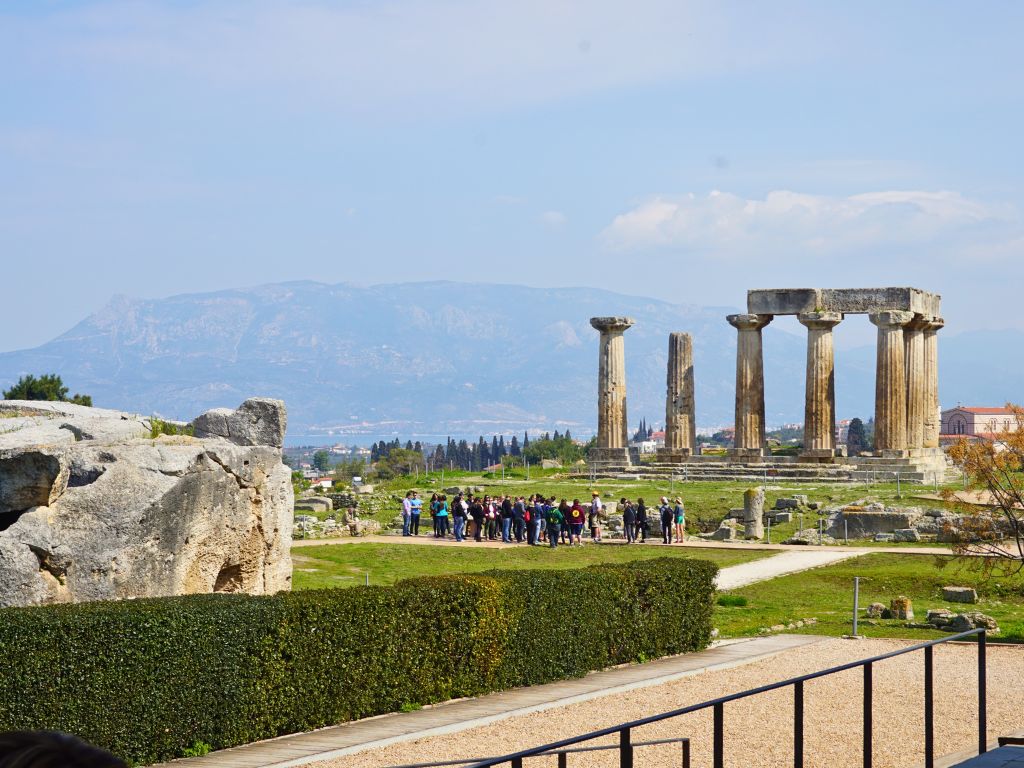
Now, let us look at Corinth. Do not forget to travel with your Bible when you visit, and you will have an incredibly special experience walking among the ruins.
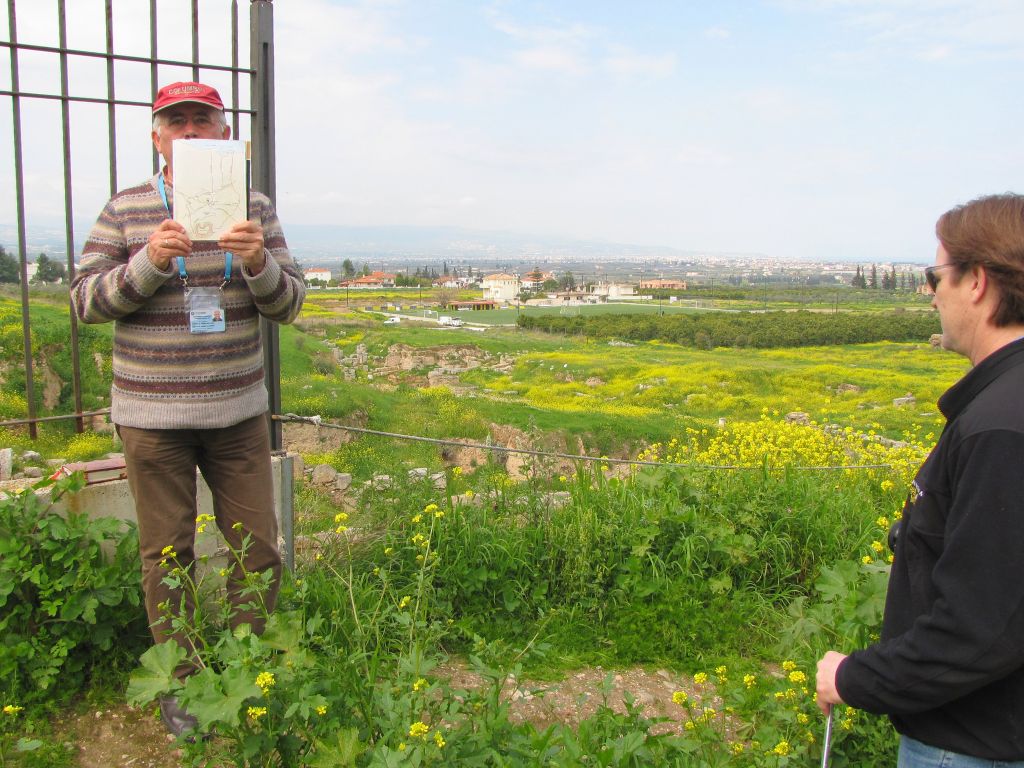
Start your tour of Corinth by finding an ancient inscription outside of the official fenced site. This inscription is extremely important for Christian apologetics and is known as the Erastus Inscription.
Who was Erastus? When writing the letter to the Romans from Corinth, Paul included greetings from the treasurer of the City of Corinth, Erastus. The Apostle Paul sent greetings from the members of the Church of Corinth to Rome. Erastus was the richest person of the richest city (Corinth) of that time. He was a person with international influence and impact, and very few people in the city could see him because he was guarded and protected. Erastus’ position of Civic Office of the Treasurer was a particularly important elected position. The candidates for the Civic Office of Treasurer would prove their economic power by offering infrastructure and monuments to Corinth. Then they served in office and after the Treasurer finished his civic office position he would then come back and offer more infrastructure, more treasures, and monuments to Corinth. Rich candidates were chosen to serve as treasurers because:
- A rich person had experiences administrating his own wealth.
- With a rich person there was less possibility of stealing and misusing public treasures for personal gain.
Paul’s record of greetings from the treasurer of the City of Corinth, Erastus, caused a big problem for the rationalists of Europe in the 19th century. Professors from Tübingen University in Germany could not accept that a personality like Erastus, the Treasurer of the City, was one of Paul’s converts. The professors proved to be persecutors and fighters against the historicity and the authenticity of the New Testament, claiming that the Apostle Paul preached only to a Jewish sect, only to the poor and slaves.
Proclaiming their atheism, the Tübingen rationalists said they were able to give a reasonable answer for everything that was supernatural, both in classical literature and in the New Testament. They claimed the Apostle Paul was a sneaky, common person who sought to impress the poor members of the Church of Rome. The rationalists accused Paul of this trick – to write in such a way to make himself important as a friend of Erastus, the Treasurer of Corinth and Erastus, claiming Erastus was his own convert. The Professors of Tübingen said this friendship and conversion was something that never could have happened. For them, even from a distance, Paul could never have had contact with such a personality of the Mediterranean world as the Treasurer of Corinth.
Another element that supported the atheists was the unusual name Erastus. The name Erastus is an extremely rare and peculiar name, a name not found in inscriptions, nor found in literature. The actual meaning of the name Erastus is “sexy.” So, who could call his son sexy? The name Erastus comes from the Greek word eros and means, “The person who is worthy to be erotically loved.”

According to the Professors of Tübingen, the Apostle Paul wrote the title, Treasurer, in his greeting, but being afraid his letter, written in Corinth, would be published before being sent to Rome, he signed the title but did not put the real name of the current treasurer. The rationalists claimed that instead of using a real name, Paul used a funny, peculiar name so that if the letter were found in Corinth, nobody could accuse Paul of using a false relationship. For the rationalists, Erastus the treasurer was nothing, but a fictional personality made up by the Apostle Paul for his own reasons.
In the 19th century there was no answer to that argument from the Christian side. But the answer came later in another way. On April 15, 1929, while digging in the area of the Theater of Corinth, the American Archaeological School discovered a pavement. On the side of the pavement, they discovered a benefactors inscription and dedication. Both the inscription, the Erastus Inscription, and the pavement are precisely dated to the middle of the first century AD, the time when Paul was in the city during his first visit to Corinth.

This inscription proved that Erastus was not a fictional personality, but a real person and the treasurer of the city when Paul was in the city. Paul was not afraid to mention his name. These two things, Paul’s writing of Erastus in the New Testament and the pavement inscription make Erastus a historically identified personality. City treasurer Erastus, convert of the Apostle Paul, offered this pavement as a gift to the city, honored to serve Corinth as treasurer. So, the inscription of Erastus brought down the whole argument of the 19th century Professors of Tübingen University. Erastus offered this pavement after he finished his services as treasurer.
The area of the Corinthian Theater is where the Erastus Inscription was found, on one of the roads. And when the theater was discovered, it was also discovered that the area had been used as a marble quarry during the Middle Ages. (And so today we have very pure remains of the foundations of the theater.) The Corinthian Theater is considered to be one of the oldest and biggest, comparable only with the theater of Ephesus, having a capacity of between 19,000 to 23,000 people.
I would like you to see a map of the ancient city of Corinth. The brown line you see identifies the city walls. (This map can be found in the best book ever published on Corinth, Ancient Corinth, by Nicos Papahatzis. I ordered mine from Amazon.) Look at the bottom of the map for the Acrocorinth/Ακροκόρινθος.
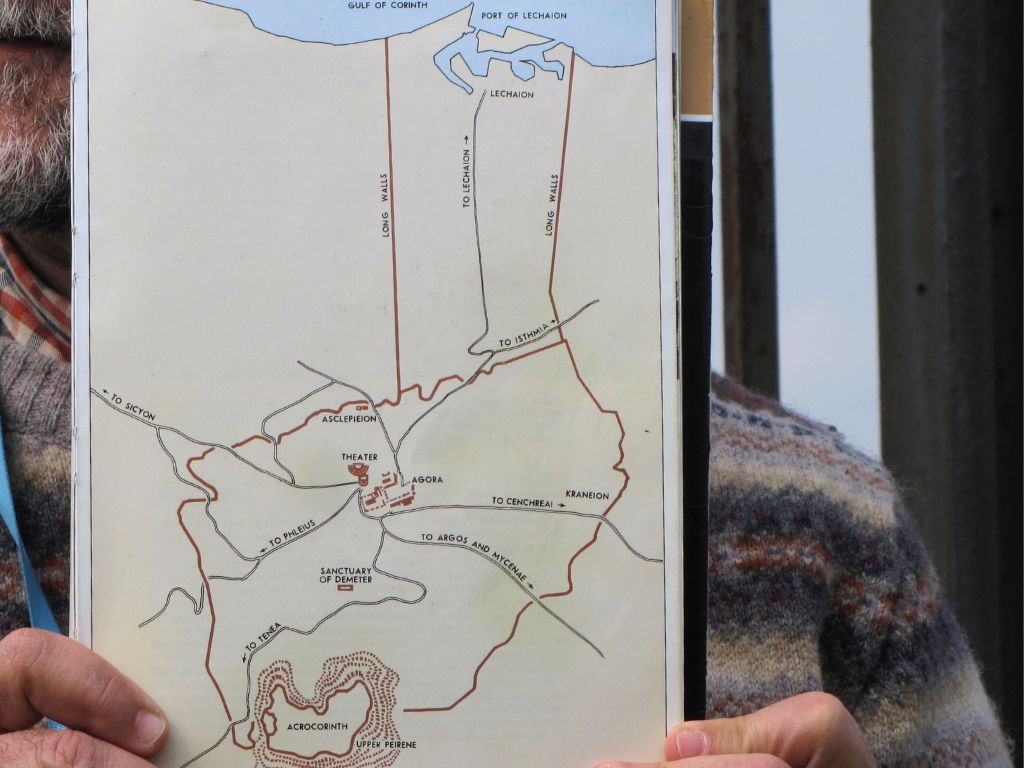

Of all this huge city the only excavated part is a little spot, less than 5%.
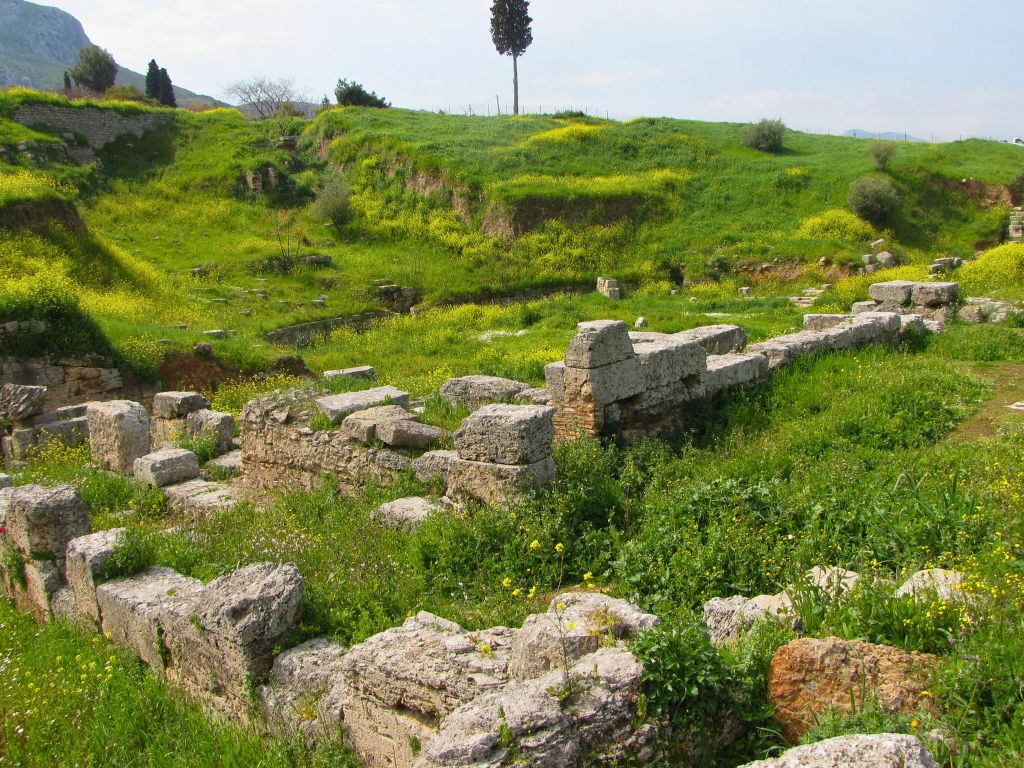


The Erastus Inscription originally was bronze, inlaid on limestone. But most of the bronze was gone when it was found, except in two little spots of punctuation points. But still, the inscription is clear.
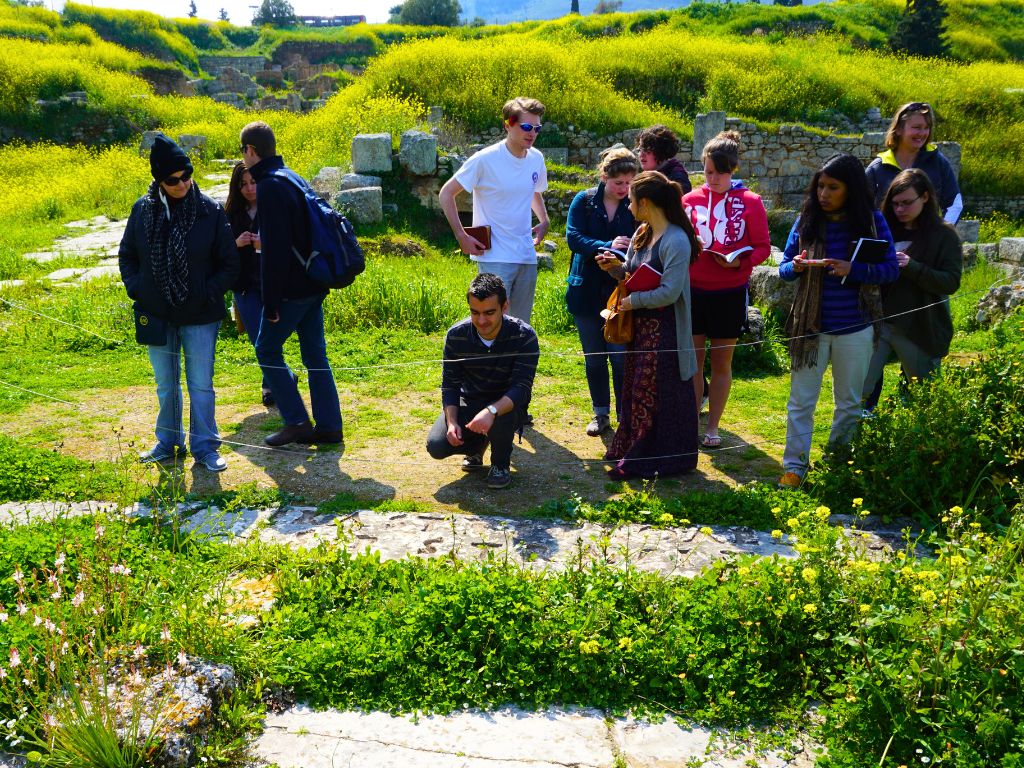


Written in a Greek speaking city, the inscription is not in Greek. The inscription is in Latin. Erastus, the benefactor, was not just one of the rich people of the city, he was also a member of the Roman administration. Latin was the language of the administration only. Remember also that the Apostle Paul, a Roman citizen, wrote his letter to the Romans in their own language, Greek. Greek was the common language among the different communities, even in Rome.
Unfortunately, unfortunately, the inscription is preserved poorly because the authorities today have forgotten about the big issue of the 19th century with Tübingen University. To them, the Erastus inscription is nothing, just a detail of Roman history. But the most unfortunate thing is the lack of interest from Christians. If the Christians could sponsor local archaeological services for preservation, the Erastus Inscription would have a better fate and better conditions.
The Erastus inscription is in Latin. The inscription reads: Erastus pro aedilitate sua pecunia stravit.
Here we have the letters E, R, A.
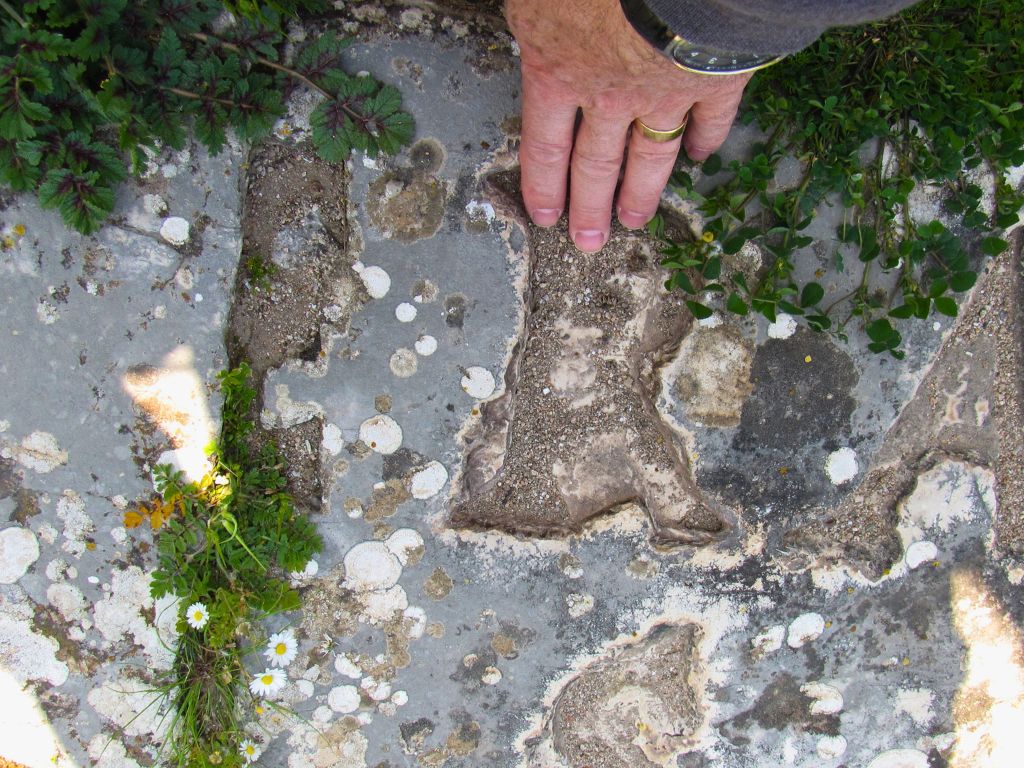
Then we have three more letters PRO and another dot. PRO means for/in return, it means to pay back. And then we have the word aedilitate, a Latin word that comes from the term aedile. Aedile is equivalent with the Greek term οἰκονόμος. Erastus pro aedilitate = Erastus for the time he was a treasurer. And then we go to read the second line. S.P. is an abbreviation of the Latin words sua pecunia. Sua pecunia means “on his own money.” Then we have the word stravit, paved.
Erastus pro aedilitate sua pecunia stravit = Erastus for the time he was a treasurer on his own money paved. In Latin, the word aedile means steward and in Greek οἰκονόμος means treasurer. In the letter to Romans the Apostle Paul uses the Greek term οἰκονόμος for treasurer.
Remember what I told you about how rare and peculiar his name is? His name means “sexy.” The name Erastus is not found in inscriptions or in literature. In the Bible, this name is mentioned not once, neither twice, but three times. Open your Bible to read about Erastus.
- Romans 16:23 “Gaius, my hosts and of the whole church salute you. Erastus the treasurer of the city salutes you and Quartus the brother.”
- Acts 19:22 “He sent two of his helpers (diακονούντων)Timothy and Erastus to Macedonia where he stayed in the province of Asia a little longer.”
The word helper (diακονούντων) means free will servant. (At that time, the term Διακονούντων was not an office in the church structure.) And the question of the rationalists was, “How is it possible such a rich and proud Greek like the Treasurer of Corinth, would become a free will servant to a poor working Jewish preacher?” They thought, “No way.” Easily we could speak about two different persons. The rich one who paved this road- the treasurer, and the poor one, the servant. But because the name Erastus is so rare, we are closer to the truth If we accept that we have one person, a rich person who became the free will servant of a poor working Jewish preacher, for his own reasons.
Remember we have this name in the Bible three times and the third time clarifies the whole issue about how many Erastus’ we have in Corinth.The Apostle Paul here speaks about the Erastus, the well-known Erastus of Corinth, who went back home.
3. 2 Timothy 4:20. “Erastus remained at Corinth, and I left Trophimus who was ill at Miletus.”
You can step on this pavement, a pavement made by a person you already know from the Bible. How would you feel? To step upon this pavement is to test the historicity and the authenticity of the New Testament – by your own figure! Even in Jerusalem you will not find such a place. Remember, that what is mentioned about Jerusalem took place in the square kilometer of the Old City. And when we visit Jerusalem, we find that the churches and later buildings have destroyed the authenticity of the place.
But the Greek Biblical sites are free of later editions and buildings, they are preserved and maintain their authenticity. You can touch them with your own figure, and know the importance, the historicity, the authenticity of the New Testament, which was doubted so many times, and still is by many.
The Acropolis of Corinth appeared as an institution and as a structure in the middle of the second millennium before Christ. It rose as a summit, the upper part of the city, and there the palace was the established sanctuary of the King Priest.
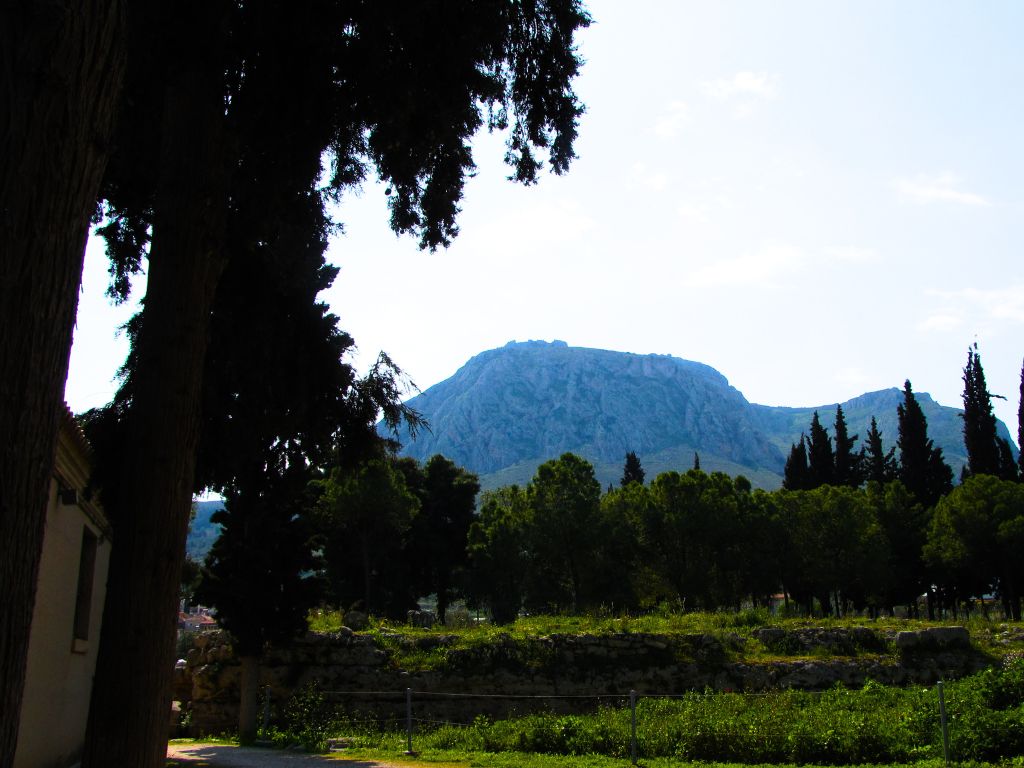

Remember we spoke about the sanctuary of the King Priest in Philippi also? A famous Corinthian King priest related with the Acropolis in that era of legend is Sisyphus. Have you heard about the Sisyphean torture? Yes. Sisyphus was an impious hubrist, King of Corinth. His palace was up there. And remember we spoke about a fear of judgment in Hades and about the classification of souls and the size of the gap called Abyss. Do you remember these things? The Elysian Fields for the pious and the place of the torture, the hell for the hubrists. And remember also that hubris was punished. Not massively like Dante said in Middle Ages that all the sinners are boiled at the same time, but personally, their hubris received – with personalized punishment. The internal personal punishment was related to the way hubris had been expressed hubris against divinity. So, when Sisyphus was judged in Hades, the decision was that he had to be down there, in judgment, in a place similar to the place where his palace used to be – like this hill in Corinth. His punishment was to roll a stone up to the top. And just when he arrived at the top, the stone was rolled down again, and he had to repeat the same effort eternally, the Sisyphean torture.
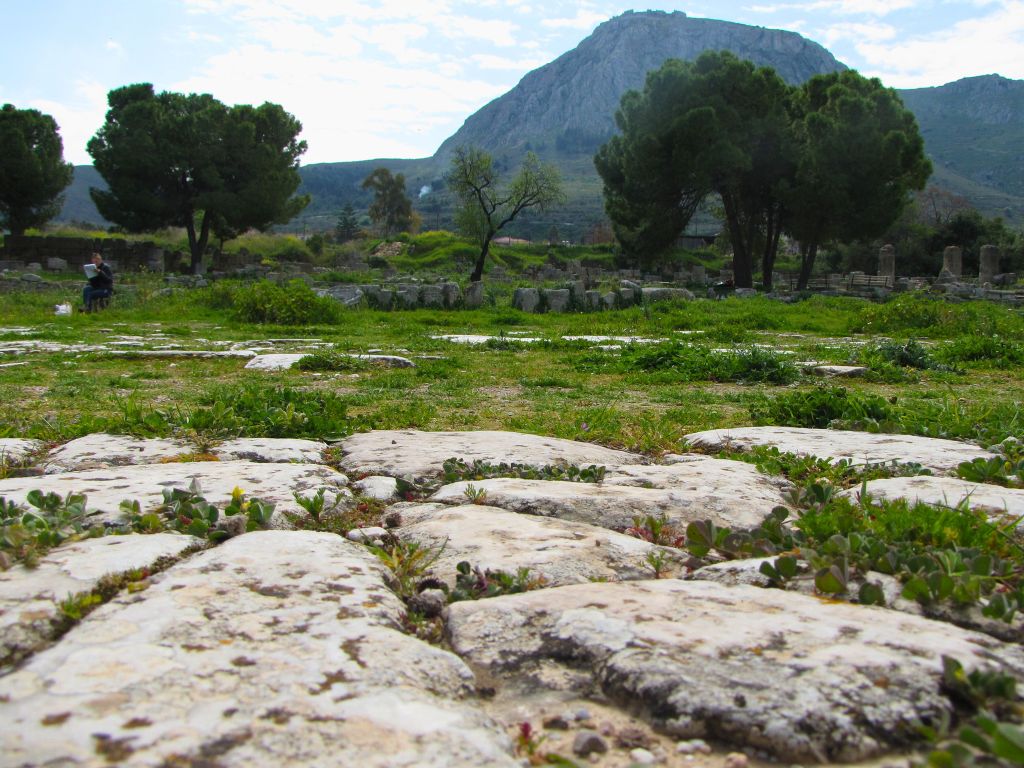
Another legendary mythological figure related to the Acropolis of Corinth is the Flying Horse Pegasus. Pegasus first touched the Earth at the summit of the Corinthian Acropolis and at this very spot a spring of fresh water came up. Still, at the top of these rocks, this freshwater spring exists. The place up there is where water is self-sufficient.
Then, when the monarchy was abolished, the Acropolis of Corinth was dedicated to the patron goddess Aphrodite (not the Virgin Goddess of Wisdom, but the beautiful Goddess of Prostitution.)
At the time of the Apostle Paul, Strabo of Amaseia was a famous geographer and historian. We know from Strabo that at the top of the summit, in the first century AD, were more than 1000 Girls, and a large number of boys too (possibly bigger than girls, we do not know exactly.) They offered their bodies for temple, sacred, prostitution. They were the slaves of the temple. And they were slaves. They belonged to the temple. Their duty was to come in groups, down to the city, to find (not clients, but…) worshippers.
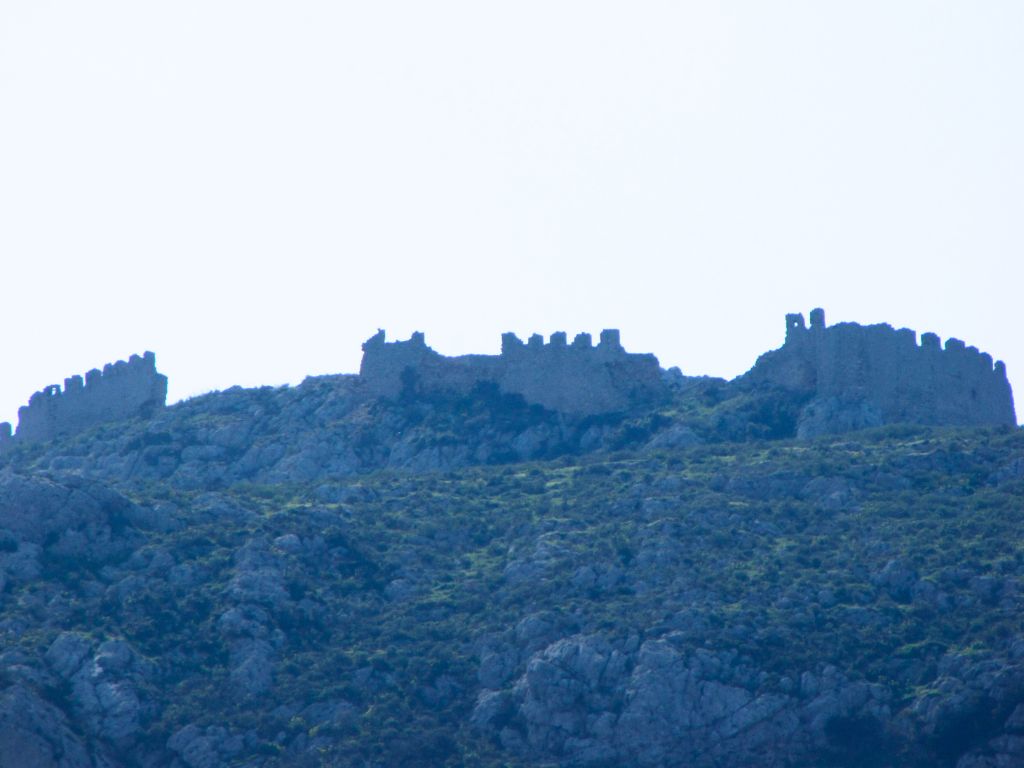
If you look at the summit, you see the wall. In the middle of the wall, you see a part that is a little bit higher (a little to the right in the photo) with some little structures at the top. That used to be the main gate to the sanctuary. This gate was closed, at the end of fourth century AD when Theodosius I abolished and destroyed the ancient pagan religion. But still today, if somebody steps on the top of this wall, he can see under his feet the ruins of a build, a path in the form of a zigzag. The slaves of the temple came down to the city in groups, like small processions, to offer their bodies as if they were little temple shaped monuments, memorial monuments. (You see memorial monuments, little churches, on the sides of roads in Greece.) The slaves’ body was considered to be a little temple for the venerators to enter and to worship the Goddess. They offered their bodies to everyone for free, and they accepted donations.
Remember, the Apostle Paul, at least two times repeats in First Corinthians, “Corinthians, be careful, your body is not the temple of Aphrodite, but the temple of the Holy Spirit.” (1 Corinthians 16:19) This sense, the concept of the body being a temple, comes from this place. So, “Corinthians, be aware in your body the Holy Spirit should be worshipped, not Aphrodite.”
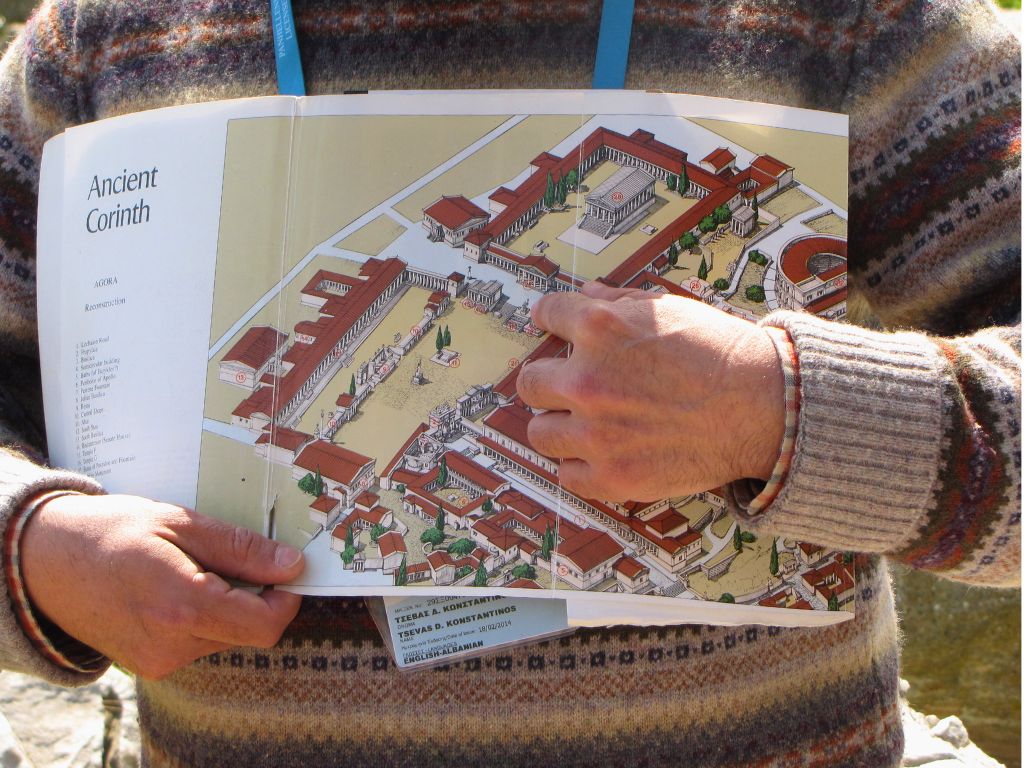


There was not a visitor of the city, rich or poor, local or foreigner who had not included in his schedule, the veneration of the Goddess through the slaves. They had become the main attraction of Corinth, and the city was famous in all the Mediterranean world because of them.
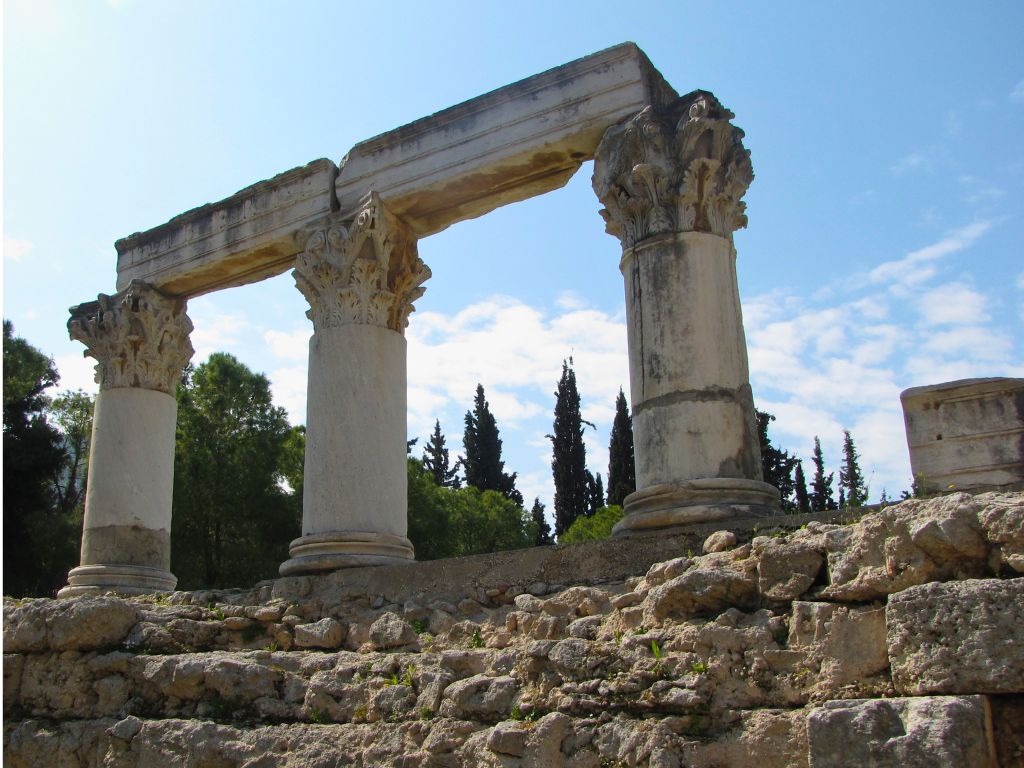
The most well-known proverb, and there were many about Corinth, was one word, Corinthizing. Corinthizing means the experience of all kinds of fleshly pleasures without limits. These slaves, coming down to the city to find worshipers, had to distinguish themselves from the other prostitutes (and the city had all kinds of prostitution.) They had two ways to make themselves known.
- The first was an inscription carved under the sandals with both letters – which said, “Follow me.” So, stepping upon the dusty roads of the city, wandering around this inscription was printed on the dust. Anyone who was interested in finding them just followed the inscription in the dust. Unbelievably cheap and effective advertisement.
- The other way for them to make themselves known was a sight, a sign from a distance. They kept all their heads shaped. So, if somebody saw a lady from a distance with a shaved head, they knew who she was without a second thought. Remember that until the middle of the 20th century in Europe there were a lot of ladies who had never cut their hair since birth, because the hair for a lady was a part of her owner and an essential part of her beauty
The prostitute slave’s impact on history was tremendously strong. Still today, the official term in the Greek law for a male or a female prostitute is the slave of the temple. In many European places, especially in the countryside, if they want to expose a lady caught committing adultery, the first thing they do to her is to shave her head. I do not know if you have read that right after the Second World War was a major event all through Europe, with a special emphasis in France, Netherlands, and Norway. All the ladies who had cooperated with the German army, they were all caught, and their head was shaved according to the Corinthian manner. So, everybody in the city could see who these ladies were during the war and what was their activities.
Definitely, Apostle Paul having been in the city, a year and a half was time enough to have contact with people in the city. The slaves of the temple were seeking, they were looking for everyone, especially new people in the city to offer themselves for the veneration of the Goddess. Definitely, some of them heard his message and they accepted the message of Apostle Paul.
But as we understand, for a man a short time was enough time for his hair to get long enough so not to be distinguished (because even at that time the men kept short hair.) But a woman who never cut her hair since birth, needed a long time until her hair could get so long, so as not to be distinguished.
And obviously, this is the cultural context of why the Apostle Paul demands from all the ladies of the Church of Corinth to be covered with a scarf – to protect these ladies, the short-haired prostitutes, from discrimination. You know, these ladies had been the common vases of men and definitely had not any chance to create a family.
Then, they came in the church. And the Apostle Paul likes to offer them the same status as all the members of the church. How? His main problem was not to persuade the poor slave ladies of the temple to be covered with a scarf. His main problem was to persuade the others, the proper ladies of the church who were proud of their long hair, to cover their long hair – for which they were proud.
Open your Bible to 1 Corinthians 11:5,6: “For every woman who prays or prophesies with her head uncovered dishonors her head. It is just as though her head were shaved. If a woman does not cover her head, she should have her hair cut off. And if it is a disgrace for a woman to have her hair cut or shaved off, she should cover her head.”
It is obvious that the apostle Paul puts a dilemma in front of the church of Corinth: My dear ladies, you have to all be shaved or all covered. And because some of you have been shaved you transmit a wrong message and that is shameful to you. Please, be all covered. And this is obviously the reason the Apostle Paul institutionalized uniformity in the church: under cover these ladies could find asylum. This gave the scarf a spiritual, a symbolic, meaning. Many times, the Apostle Paul is accused as anti-woman. But if we study his life, we see exactly the opposite. He does the best he can even for these ladies, the slaves of the temple, giving them the same status in the church as the others.
What do you think it was like for a person, lady, or gentleman, who belonged to this prostitute group to one day go to the High Priestess of the temple of Aphrodite and say, “My dear High Priestess, I changed my faith. Now I believe in another God…and goodbye.” Do you think it was so easy for them? They were property of the temple. Slaves. Somebody had to buy them at the price that the temple should ask. And as you understand, young slaves were extremely expensive. Somebody had to redeem them, and somebody did it. So, we had these new people in the church and the church was called to face that problem. If there was not a redeemer of these people, we would never have to speak about the scar and the problem of the church in First Corinthians 11:5, 6. What do you think about that dilemma? We do not know how we would solve the problem. The Bible does not directly tell us the solution, but the Church of Corinth had as a member of the church one of the richest people of the Mediterranean world, the treasurer Erastus. And here we have God’s humor, perhaps it was Erastus, the sexy one, who delivered the sex slaves of the temple from sex slavery.